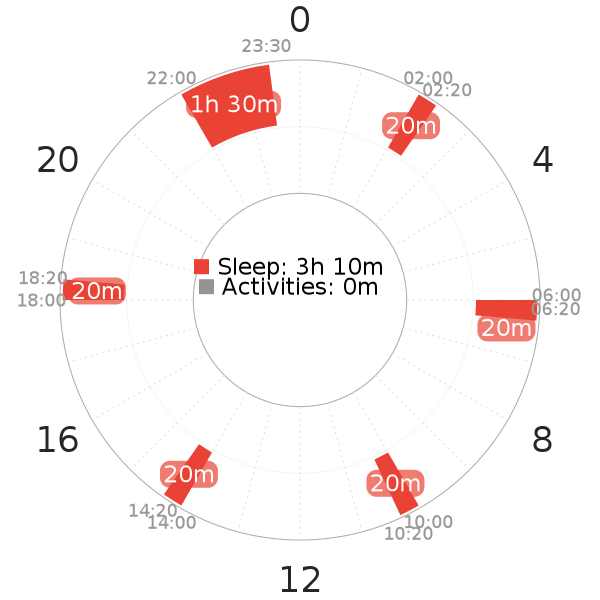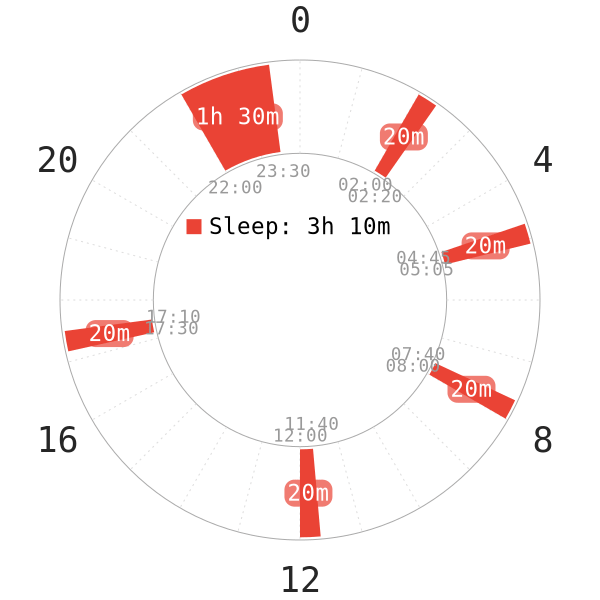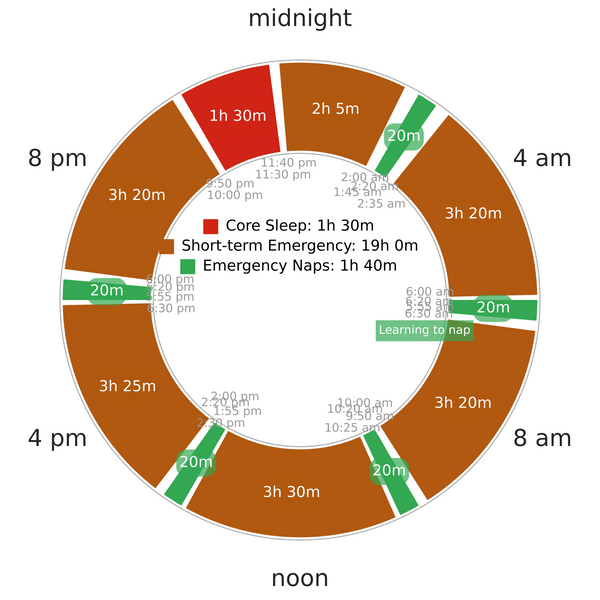
Everyman 5, or E5, is the last schedule in the Everyman series. It has the most number of naps per day (5) out of all Everyman schedules. Because of a total sleep of only more than 3 hours, it is the last transition step before Uberman sleep (2h total sleep) in the rhythmic preservation path to Uberman. This schedule’s total sleep is below the minimum threshold for long-term sustenance; thus, average sleepers should not attempt this schedule.
Content
History
Everyman 5, is the last schedule in the Everyman series. Puredoxyk proposed this Everyman variant in her book Ubersleep, as part of the Formula. An Everyman schedule should have 4-5 naps per day with a core sleep of only 1 full cycle. As the last schedule, E5’s core is at the minimum duration for a core sleep (90m).
Despite Puredoxyk’s proposal, she did not mention any details about how to optimally schedule E5. Until recently, the Polyphasic Discord Community proposed it as a way to transition to Uberman.
Mechanism
- Similar to E4, E5 can create an impression of a nap-only schedule, as the core only has 1-cycle duration; in addition, a 90m duration is often mistaken for a “nap” outside of polyphasic sleep’s context.
- The core will contain the bulk of SWS.
- The naps will relieve REM pressure and sustain alertness. They spread across the day, looking somewhat equidistant from one another to resemble Uberman sleep (~3-4h wake between each sleep).
- One nap is always around the graveyard hours. This is very likely an SWS nap on the schedule. It is expected that SWS likely will enter this nap in case of normal SWS requirements.
- The latest nap in the day, located around late afternoon/early evening hours (~6 PM) may also contain SWS because of the high sleep pressure.
- After adaptation is complete, presumably the core cycle length can reduce to ~60m because of the high frequency of naps. The core should then contain mostly light sleep and SWS while REM sleep is dominant in the naps.
Adaptation
There has been no successful adaptation to E5 up to date. There have been few attempts with a hope to decrease E4’s difficulty with an extra nap; nevertheless, all attempts ended in swift failure. Like other polyphasic schedules, there are adaptation methods that can be useful to adapt to E5 if desired.
Regardless of the methods, the overcoming the intensified repartitioning process is mandatory for any polyphasic sleepers to eventually succeed.
Cold Turkey
Because there is a nap in the middle of the night, it makes the adaptation to this schedule itself, or even just a temporary transition a very challenging aspect. As core body temperature drops around nighttime hours which facilitates sleep, core sleeps are preferable to short naps.
An immediate transition from monophasic sleep will first cause naps to contain light sleep or trace SWS like usual. As REM pressure rises, it will then compete with SWS during repartitioning.
Individuals with normal sleep requirements will only incur more sleep debts on this schedule; the total sleep will fail to meet the demand for sufficient SWS and REM daily.
Gradual Adaptation
It is possible to transition to E5 from E3 (3-3.5h core) or any other Everyman schedules. However, there is no known successful adaptation either.
Difficulty
For the most part, E5 adaptation is similar to E4, if not more intense. The core sleep cannot support a regular amount of SWS requirements, so any naps in the day can generate SWS wakes.
Once REM pressure builds up, adapters will have to manage the intense sleep inertia from each REM wake. Long crashes can occur frequently during adaptation due to SWS wakes.
- Stage 3 can arrive only a couple days in, because of a gargantuan sleep reduction from a regular monophasic duration.
- With the high density of sleep across the day, initially it will be difficult to fall asleep in many naps in a row. This problem is more exacerbated in beginners and non-nappers.
- Then, this would increase the chance to oversleep in the late nap in the day, or the core sleep the following day(s).
- Despite having 20m of extra sleep compared to E4, the extra nap only serves to somewhat provide more alertness. As adaptation progresses, this extra nap can become a liability; it provides one extra opportunity for a nasty SWS wake.
- Any oversleeps would endanger the adaptation in a much greater magnitude than on schedules with more sleep.
All in all, it may be better to stay on E5 for a short amount of time, before making an immediate transition to Uberman (fast adaptation). This would limit as much built-up sleep deprivation as possible. However, no successful Uberman sleepers are known to have transitioned from E5 either.
Alternate Variants
Since there has been no successful adaptations to E5, there are possible variants that may or may not work. This is merely based on how successful Everyman variants look like over the width of history.
There can also be other unexplored options regarding napping mechanics, but they require more adaptation samples. Extended versions may be possible, but at this point E3-extended or E4-extended would be better.
Night Sleep Focus

This E5 variant attempts to shift more naps into the night; this in return leaves only 2 daytime naps. If adaptation is possible, it will create longer wake periods in the day, with a nap during lunch and after work.
However, the cluster of nocturnal naps may be utterly difficult to adapt to; the high possibility of SWS wakes at night will creep into many naps.
- It is also unknown how long would be an optimal wake duration between each nap.
- Due to the low total sleep, the naps on E5 likely will not yield as much wakefulness than on other less extreme Everyman schedules. As a result, stocking up napping at night may not do enough to help offset the tiredness periods during the daytime wake gaps.
Research
Interested in a research paper for Everyman 5? Click here to find out.
Lifestyle Considerations
With an excessive amount of naps spread in the day, Everyman 5 suffers from various downsides:
- Social commitments, extracurricular activities and standard occupations (e.g, 9-to-5) are largely impossible.
- It is also very inconvenient to have to sleep again after ~1.5-2h awake at night for a lot of people.
- The immense adaptation difficulty is not worth an attempt.
- As a standalone schedule, E5 generally has poor sleep design and is outclassed by E4. Even E4 has some success over the years, thanks to the more reasonable homeostatic distance of wake hours between each sleep.
- Like any other schedules below the minimum sleep threshold, E5 also poses potential long-term health issues.
It also seems unlikely if Everyman 5 will ever gather enough attempts due to its highly constrained scheduling. There are some niches that it can offer, however.
Utilities

- One can choose to have a short core sleep for some SWS, and then enjoy the several naps on E5 as a way to learn to nap effectively.
- This is basically a less extreme Naptation version, which would conserve some daytime productivity. The core sleep with some SWS can help consolidate memory and power up overall performance better than skipping sleep entirely.
- In an emergency that requires a lot of sleep cut, E5 can be a temporary schedule with several naps to boost alertness. The short naps have their advantage of being easier to fit into daily schedule; they also allow sustained operations where no core sleeps are possible.
Being a middle ground between the insane Uberman and a more sustainable E3 (or even E4-extended), E5 has the worst of all worlds. It is almost as inflexible as Uberman and the likes of E4, while also potentially unsustainable long-term for reasons above. Beginners and average polyphasic sleepers should not try to adapt to this schedule aside from some niche situations above.
Main author: GeneralNguyen
Page last updated: 8 April 2021
